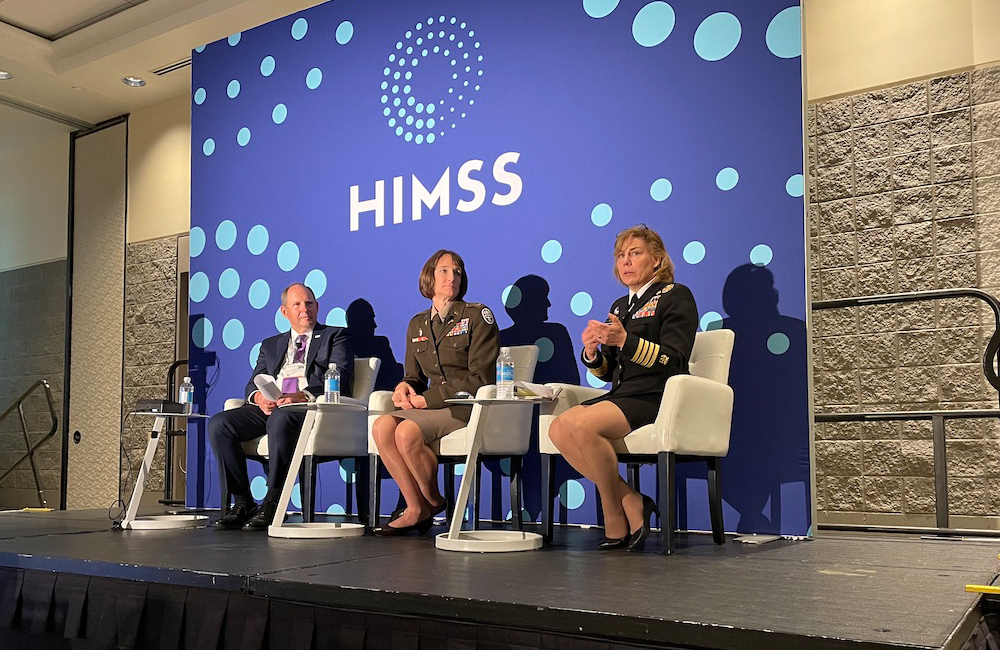DOD Wants a Holistic Health Data Ecosystem to Measure Military Readiness

Key areas in maintaining military readiness go beyond systems and weapons — they include the health of the very service members across all military service branches.
“Our soldier, our warfighter, those folks that serve our nation are the most prized weapon system that we have,” said Col. Deydre Teyhen, simultaneously serving as the Army Medical Command’s deputy chief of staff of the G-1/4/6 and the Army Medical Specialist Corps’ 20th chief. “We need our soldiers to be able to see … and make the right decision at the right time. That requires not just smart decisions, but that they’re not physically exhausted, that they have the stamina and resilience to be able to make the right decision at the right time.”
Teyhen was speaking Wednesday at the HIMSS conference in Orlando, Florida, on a panel about Defense Department efforts to build a data ecosystem that supports the health of service members. This includes connecting eight different dimensions that DOD sees as critical to optimizing health, performance and readiness holistically.
But creating a data ecosystem that can be used in various predictive modeling efforts or even health treatments for the service member to ensure that readiness is still in its infancy.
This is because having a 360-degree view of health requires collecting and making use of information obtained in different places that have different levels of reliability and accuracy, noted Capt. Kimberly Elenberg at the conference. Elenberg is aligned to the deputy secretary of defense Enterprise Analytics Support Directorate as the lead strategist for DOD Enterprise Health Analytics and Warrior Performance Lines of Effort.
A true holistic and fully functioning data ecosystem, she added, incorporates data from public health surveillance, individual health and also medical intelligence. This means merging data sets that are latent, not entirely accurate and more predictive in nature.
This program — Total Force Fitness — aims to collect data from all aspects of health, including spiritual, sleep, activity, nutrition and medical readiness. It’s an effort Teyhen refers to as building a “digital health environment around the soldier.”
This growth in data obtained from technologies like wearables and other self-reporting applications can have valuable potential in applying other technologies like artificial intelligence to understand optimal human performance and enable predictive analytics. Its what the speakers referred to as the “whole health data convergence” — similar to the DOD’s Joint All Domain Command and Control (JADC2) effort to connect sensor data for immediate decision-making on the battlefield.
Just like JADC2, connecting that data and making it actionable is challenging. Current challenges around this health ecosystem of a service member include questions on how the data is obtained, how it’s processed, how it’s shared and, of course, how it’s secured or kept private.
“Right now we have a human being that can read something and then determine the classification,” said Elenberg. “But as we get faster at joining data and we start applying machine learning and AI to it, those classification levels could change very quickly, and I think we’ll need an algorithm that can help us understand that. … When does the classification level of that data change?”
There’s also the cybersecurity considerations. Once a service member is in a deployed setting, there’s going to be a much larger need for cybersecurity so they don’t end up with their apps providing a digital footprint. This also includes in environments where you are required to remove your electronic devices.
“That’s a wicked, wicked problem to solve, and it has to be from the foundation of solving it,” Teyhen said.
Over the next several years, defense leaders building out this wearables ecosystem see the challenge as not just being one about connectivity, it’s to ensure that the devices and sensors are not just another “internet of things,” Teyhen said.
Then once the data is collected, Elenberg said, there’s the imperative of moving “from the ‘what’ to the ‘so what.’”
This is a carousel with manually rotating slides. Use Next and Previous buttons to navigate or jump to a slide with the slide dots
-

VA CIO Targets Modern IT and Smarter Workforce Alignment
Agency leaders told lawmakers they are focused on trimming legacy systems and restructuring its workforce to streamline operations.
3m read -

Pentagon's $200M AI Contracts Signal Broader Effort to Transform Talent
The Army is leveraging Silicon Valley, reservist programs and new hiring strategies to integrate critical digital skills in its ranks.
5m read -

AI Foundations Driving Government Efficiency
Federal agencies are modernizing systems, managing risk and building trust to scale responsible AI and drive government efficiency.
43m watch -

Inside DOD’s Push to Grow the Cyber Workforce Through Academia
Diba Hadi gives her first interview since becoming principal director of the DOD’s Cyber Academic Engagement Office.
15m listen -

Agencies Tackle Infrastructure Challenges to Drive AI Adoption
Federal agencies are rethinking data strategies and IT modernization to drive mission impact and operational efficiency as new presidential directives guide next steps.
5m read Partner Content -

Generative AI Demands Federal Workforce Readiness, Officials Say
NASA and DOI outline new generative AI use cases and stress that successful AI adoption depends on strong change management.
6m read -

The Next AI Wave Requires Stronger Cyber Defenses, Data Management
IT officials warn of new vulnerabilities posed by AI as agencies continue to leverage the tech to boost operational efficiency.
5m read -

Federal CIOs Push for ROI-Focused Modernization to Advance Mission Goals
CIOs focus on return on investment, data governance and application modernization to drive mission outcomes as agencies adopt new tech tools.
4m read -

Fed Efficiency Drive Includes Code-Sharing Law, Metahumans
By reusing existing code instead of rewriting it, agencies could dramatically cut costs under the soon-to-be-enacted SHARE IT Act.
5m read -

Agencies Push Data-Driven Acquisition Reforms to Boost Efficiency
New initiatives aim to increase visibility of agency spending, improve data quality and create avenues to deploy solutions across government.
5m read -

Data Transparency Essential to Government Reform, Rep. Sessions Says
Co-Chair of the Congressional DOGE Caucus Rep. Pete Sessions calls for data sharing and partnerships to reduce waste and improve efficiency.
5m read -

DOD Turns to Skills-Based Hiring to Build Next-Gen Cyber Workforce
Mark Gorak discusses DOD’s efforts to build a diverse cyber workforce, including skills-based hiring and partnerships with over 480 schools.
20m listen




